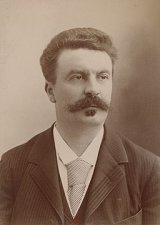The Trip of le Horla
"The Trip of le Horla" by Guy de Maupassant is a short story that explores themes of existential dread, madness, and the supernatural. Narrated from the perspective of a man grappling with a mysterious and malevolent force, the story delves into the psychological turmoil and eerie experiences that blur the lines between reality and hallucination. Maupassant's signature style captures the protagonist's descent into paranoia, as he confronts the haunting presence of the Horla, a spectral entity that embodies his fears and insecurities. The tale serves as a reflection on the duality of the human psyche and the struggles against unseen influences.
On the morning of July 8th I received the following telegram: “Fine day. Always my predictions. Belgian frontier. Baggage and servants left at noon at the social session. Beginning of manoeuvres at three. So I will wait for you at the works from five o'clock on. Jovis.” At five o'clock sharp I entered the gas works of La Villette. It might have been mistaken for the colossal ruins of an old town inhabited by Cyclops. There were immense dark avenues separating heavy gasometers standing one behind another, like monstrous columns, unequally high and, undoubtedly, in the past the supports of some tremendous, some fearful iron edifice. The balloon was lying in the courtyard and had the appearance of a cake made of yellow cloth, flattened on the ground under a rope. That is called placing a balloon in a sweep-net, and, in fact, it appeared like an enormous fish. Two or three hundred people were looking at it, sitting or standing, and some were examining the basket, a nice little square basket for a human cargo, bearing on its side in gold letters on a mahogany plate the words: Le Horla. Suddenly the people began to stand back, for the gas was beginning to enter into the balloon through a long tube of yellow cloth, which lay on the soil, swelling and undulating like an enormous worm. But another thought, another picture occurs to every mind. It is thus that nature itself nourishes beings until their birth. The creature that will rise soon begins to move, and the attendants of Captain Jovis, as Le Horla grew larger, spread and put in place the net which covers it, so that the pressure will be regular and equally distributed at every point. The operation is very delicate and very important, for the resistance of the cotton cloth of which the balloon is made is figured not in proportion to the contact surface of this cloth with the net, but in proportion to the links of the basket. Le Horla, moreover, has been designed by M. Mallet, constructed under his own eyes and made by himself. Everything had been made in the shops of M. Jovis by his own working staff and nothing was made outside. We must add that everything was new in this balloon, from the varnish to the valve, those two essential parts of a balloon. Both must render the cloth gas-proof, as the sides of a ship are waterproof. The old varnishes, made with a base of linseed oil, sometimes fermented and thus burned the cloth, which in a short time would tear like a piece of paper. The valves were apt to close imperfectly after being opened and when the covering called “cataplasme” was injured. The fall of M. L'Hoste in the open sea during the night proved the imperfection of the old system. The two discoveries of Captain Jovis, the varnish principally, are of inestimable value in the art of ballooning. The crowd has begun to talk, and some men, who appear to be specialists, affirm with authority that we shall come down before reaching the fortifications. Several other things have been criticized in this novel type of balloon with which we are about to experiment with so much pleasure and success. It is growing slowly but surely. Some small holes and scratches made in transit have been discovered, and we cover them and plug them with a little piece of paper applied on the cloth while wet. This method of repairing alarms and mystifies the public. While Captain Jovis and his assistants are busy with the last details, the travellers go to dine in the canteen of the gas-works, according to the established custom. When we come out again the balloon is swaying, enormous and transparent, a prodigious golden fruit, a fantastic pear which is still ripening, covered by the last rays of the setting sun. Now the basket is attached, the barometers are brought, the siren, which we will blow to our hearts' content, is also brought, also the two trumpets, the eatables, the overcoats and raincoats, all the small articles that can go with the men in that flying basket. As the wind pushes the balloon against the gasometers, it is necessary to steady it now and then, to avoid an accident at the start. Captain Jovis is now ready and calls all the passengers. Lieutenant Mallet jumps aboard, climbing first on the aerial net between the basket and the balloon, from which he will watch during the night the movements of Le Horla across the skies, as the officer on watch, standing on starboard, watches the course of a ship. M. Etierine Beer gets in after him, then comes M. Paul Bessand, then M. Patrice Eyries and I get in last. But the basket is too heavy for the balloon, considering the long trip to be taken, and M. Eyries has to get out, not without great regret. M. Joliet, standing erect on the edge of the basket, begs the ladies, in very gallant terms, to stand aside a little, for he is afraid he might throw sand on their hats in rising. Then he commands: “Let it loose,” and, cutting with one stroke of his knife the ropes that hold the balloon to the ground, he gives Le Horla its liberty. In one second we fly skyward. Nothing can be heard; we float, we rise, we fly, we glide. Our friends shout with glee and applaud, but we hardly hear them, we hardly see them. We are already so far, so high! What? Are we really leaving these people down there? Is it possible? Paris spreads out beneath us, a dark bluish patch, cut by its streets, from which rise, here and there, domes, towers, steeples, then around it the plain, the country, traversed by long roads, thin and white, amidst green fields of a tender or dark green, and woods almost black. The Seine appears like a coiled snake, asleep, of which we see neither head nor tail; it crosses Paris, and the entire field resembles an immense basin of prairies and forests dotted here and there by mountains, hardly visible in the horizon. The sun, which we could no longer see down below, now reappears as though it were about to rise again, and our balloon seems to be lighted; it must appear like a star to the people who are looking up. M. Mallet every few seconds throws a cigarette paper into-space and says quietly: “We are rising, always rising,” while Captain Jovis, radiant with joy, rubs his hands together and repeats: “Eh? this varnish? Isn't it good?” In fact, we can see whether we are rising or sinking only by throwing a cigarette paper out of the basket now and then. If this paper appears to fall down like a stone, it means that the balloon is rising; if it appears to shoot skyward the balloon is descending. The two barometers mark about five hundred meters, and we gaze with enthusiastic admiration at the earth we are leaving and to which we are not attached in any way; it looks like a colored map, an immense plan of the country. All its noises, however, rise to our ears very distinctly, easily recognizable. We hear the sound of the wheels rolling in the streets, the snap of a whip, the cries of drivers, the rolling and whistling of trains and the laughter of small boys running after one
Translation
Translate and read this book in other languages:
Select another language:
- - Select -
- 简体中文 (Chinese - Simplified)
- 繁體中文 (Chinese - Traditional)
- Español (Spanish)
- Esperanto (Esperanto)
- 日本語 (Japanese)
- Português (Portuguese)
- Deutsch (German)
- العربية (Arabic)
- Français (French)
- Русский (Russian)
- ಕನ್ನಡ (Kannada)
- 한국어 (Korean)
- עברית (Hebrew)
- Gaeilge (Irish)
- Українська (Ukrainian)
- اردو (Urdu)
- Magyar (Hungarian)
- मानक हिन्दी (Hindi)
- Indonesia (Indonesian)
- Italiano (Italian)
- தமிழ் (Tamil)
- Türkçe (Turkish)
- తెలుగు (Telugu)
- ภาษาไทย (Thai)
- Tiếng Việt (Vietnamese)
- Čeština (Czech)
- Polski (Polish)
- Bahasa Indonesia (Indonesian)
- Românește (Romanian)
- Nederlands (Dutch)
- Ελληνικά (Greek)
- Latinum (Latin)
- Svenska (Swedish)
- Dansk (Danish)
- Suomi (Finnish)
- فارسی (Persian)
- ייִדיש (Yiddish)
- հայերեն (Armenian)
- Norsk (Norwegian)
- English (English)
Citation
Use the citation below to add this book to your bibliography:
Style:MLAChicagoAPA
"The Trip of le Horla Books." Literature.com. STANDS4 LLC, 2025. Web. 9 Mar. 2025. <https://www.literature.com/book/the_trip_of_le_horla_4041>.








Discuss this The Trip of le Horla book with the community:
Report Comment
We're doing our best to make sure our content is useful, accurate and safe.
If by any chance you spot an inappropriate comment while navigating through our website please use this form to let us know, and we'll take care of it shortly.
Attachment
You need to be logged in to favorite.
Log In